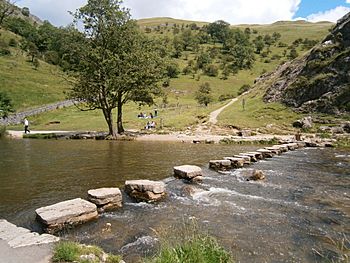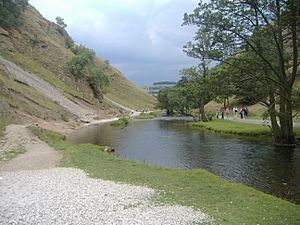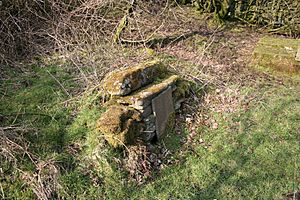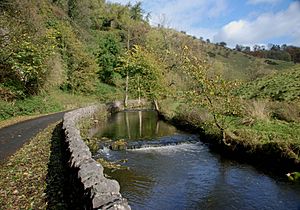River Dove, central England facts for kids
Quick facts for kids Dove (Derbyshire & Staffordshire) |
|
|---|---|

The stepping stones over the River Dove, Dovedale
|
|
| Country | England |
| Region | Staffordshire, Derbyshire |
| District | Beresford Dale, Wolfscote Dale, Milldale, Dovedale |
| Physical characteristics | |
| Main source | Dove Head Axe Edge Moor, Peak District, England 84 m (276 ft) 53°13′04″N 1°56′36″W / 53.21790°N 1.94346°W |
| River mouth | Newton Solney, Derbyshire, England 52°49′54″N 1°35′10″W / 52.83156°N 1.58601°W |
| Length | 72 km (45 mi) |
| Basin features | |
| Tributaries |
|
The River Dove is a very important river in the southwestern Peak District in England. It is about 72 kilometers (45 miles) long. The river starts on Axe Edge Moor near Buxton. It then flows south until it joins the River Trent at Newton Solney. From there, its water travels to the North Sea through the Humber Estuary.
For most of its journey, the River Dove forms the border between two counties: Staffordshire (to the west) and Derbyshire (to the east). The river winds its way past towns like Longnor and Hartington. It also cuts through deep limestone valleys called gorges. These include Beresford Dale, Wolfscote Dale, Milldale, and Dovedale.
The River Dove is famous for its trout fishing. A special building called Charles Cotton's Fishing House stands by the river near Hartington. This house inspired a famous book called The Compleat Angler by Izaak Walton.
The river's name is usually said to rhyme with "love" today. However, it used to rhyme with "rove." Some people who live near the lower part of the river still use the older pronunciation.
Contents
Dovedale: A Beautiful Valley
From Hartington to where it meets the River Manifold at Ilam, the River Dove flows through many beautiful limestone valleys. These valleys are all known together as Dovedale. The name Dovedale is also used for the specific part of the river between the famous stepping stones under Thorpe Cloud and Milldale.
The Dovedale gorge is so lovely that about a million people visit it every year. There are good paths along the river, making it easy for walkers to explore the whole area.
Much of Dovedale is owned by the National Trust. They bought Dovedale in 1934 and added more land until 1938. Wolfscote Dale was added in 1948. In 2006, Dovedale was made a national nature reserve. This means it's a special place protected for its wildlife and natural beauty.
Dovedale has many interesting sights. These include tall rock pillars like Ilam Rock and Viator's Bridge. There are also cool limestone features such as Lovers' Leap and Reynard's Cave.
The Lower Part of the River Dove
Once the River Dove leaves Dovedale, it joins with the Manifold. It then enters a wider valley near Thorpe. The valley gets even bigger as the river continues south. It passes Mapleton and then Mayfield. At Mayfield, a very old bridge called Hanging Bridge crosses the river. Here, the Bentley Brook joins the Dove. Nearby, at Church Mayfield, the Henmore Brook also flows into the river.
The Dove then flows southwest, passing Norbury and Ellastone. It turns south until it reaches Rocester. South of Rocester, at Combridge, the River Churnet joins the Dove. This is the Dove's largest tributary. When the river reaches the old Dove Bridge, the River Tean also joins it. The river now winds through a wide valley. It turns east as it flows between Doveridge and Uttoxeter. Uttoxeter is the only town directly along the river's path.
Further along, villages like Marchington, Sudbury, and Scropton are usually found at the edge of the valley. However, the village of Hatton spreads across the valley floor. It is connected by a bridge to Tutbury. Tutbury Castle looks over this crossing point. The river keeps flowing east, passing the villages of Marston, Rolleston, and Egginton. Here, its last tributary, the Hilton Brook, joins it.
At this point, the river splits. Some of its water flows through a channel called a mill fleam at Clay Mills. The two parts of the river then join back together downstream of the A38 road bridge and Monks Bridge. Finally, to the south, the River Dove meets the River Trent at Newton Solney.
Tributaries of the River Dove
A tributary is a smaller river or stream that flows into a larger river. Here is a list of the streams and rivers that join the River Dove:
- Alders Brook (joins near Rocester)
- Bentley Brook
- River Churnet
- Foston Brook (joins near Rocester)
- Henmore Brook
- Hilton Brook
- River Manifold
- Marchington Brook (joins near Marchington)
- Marston Brook (joins near Marchington)
- Picknall Brook (joins near Uttoxeter)
- Rolleston Brook (joins near Rolleston on Dove)
- River Tean
- Tit Brook (joins near Ellastone)
See also
 In Spanish: Río Dove (Inglaterra central) para niños
In Spanish: Río Dove (Inglaterra central) para niños





